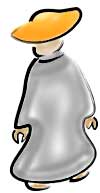On The Way: The Daily Zen Journal
Daio’s Letters to Meditators
Daio (1235-1309)
To Genan:
The peak experience, the final act, as soon as you try to pursue it in thought, there are white clouds for a thousand miles. Don’t stick to the ruts in the road of the ancients – you must travel a living road of your own. East, west, foot up, foot down, using it directly – only then will you know the peak experience that illumines the heavens and covers the earth, illumines the past and flashes through the present. This is your own place to settle and live. When I say  this, I am only using water to offer flowers, never adding anything extra. Think of this.
this, I am only using water to offer flowers, never adding anything extra. Think of this.
To Zen Man Kusho:
The cause and conditions of the one great concern of the enlightened ones is not apart from your daily affairs; there is no difference between here and there – it pervades past and present, shining through the heavens mirroring the earth. That is why it is said that everything in the last myriad eons is right in the present.
Before any signs become distinct, before any illustration is evident, concentrate fiercely, looking, coming or going, till your effort is completely ripe and in the moment of a thought you attain union. The mind of birth and death is destroyed, and suddenly you clearly see your original appearance, the scene of your native land.
Each particular distinctly clear, you then see and hear just as the buddhas did, know and act as the enlightened ancestors did. Only then do you really manage to avoid defeat in your original purpose of leaving home and society and traveling for knowledge and enlightenment. Zen man Kusho, work on this.
To Zen Man Genchu:
Since ancient times, the enlightened ancestors appearing in the world relied just on their own fundamental experience to reveal something of what is before us…. Even though this is so, eminent Genchu, you have traveled all over and spent a long time in monasteries, just go by the living road you see on your own; going east, going west, like a hawk sailing through the skies. In the blink of an eye you can cross over to the other side.
If you are not yet capable of this, then look directly at the time before the enlightened ones were present, before the world was differentiated; twenty-four hours a day, walking, standing, sitting, reclining, carefully, continuously, closely, minutely, look, look, all the time.
When this directed effort becomes fully developed and pure, suddenly in an instant you are united, the routine mind is shattered, and you see the fundamental countenance, the scenery of the basic ground. Everything will be distinctly clear; it is as if ten suns were shining.
When you get to this state, you should be even more careful and thorough going. Why? At the last word you finally reach the impenetrable barrier.
Daio (1235-1309)
excerpted from The Original Face-An Anthology of Rinzai Zen -Translated by Thomas Cleary 1978
“If where you stand is reality, then your actions have power.”
 Ever since antiquity, with excellence beyond measure, the saints and sages have experienced this Great Cause alone, as if planting great potential and capacity. Without setting up stages, they abruptly transcend to realize this essence alone.
Ever since antiquity, with excellence beyond measure, the saints and sages have experienced this Great Cause alone, as if planting great potential and capacity. Without setting up stages, they abruptly transcend to realize this essence alone.
Since before the time when nothing existed, this essence has been ever still and unmoved, determining the basis of all conscious beings. It permeates all times and is beyond all thought. It is beyond holy and ordinary and transcends all knowledge and views. It has never fluctuated or wavered: it is there, pure and naked and full of life. All beings, both animate and inanimate, have it complete within them.
If you can turn fast on top of things, everything will be in your grasp. Capturing and releasing, rolling up and rolling out-all can be transformed. At all times remain peaceful and tranquil, without having anything whatsoever hanging on your mind.
In action you accord with the situation and its potential, holding the means of discernment within yourself. Shifting and changing and successfully adapting, you attain Great Freedom – all things and all circumstances open up before your blade, like bamboo splitting, all “bending down with the wind.”
Therefore, if where you stand is reality, then your actions have power. Turning the topmost key, achieving something that cannot be taken away in ten thousand generations, you see and hear the same way as the ancient buddhas and share the same knowledge and functioning.
Yuanwu (1063-1135)
Taken from Zen Letters-Teachings of Yuanwu-Translated by J.C. Cleary and Thomas Cleary 1994




Oftentimes it is in the informal talks and letters of a teacher that we get the real sense and heart of what it is they teach. Both the above selections were taken from letters or personal instructions given upon a student’s departure.
Yuanwu is best known as the author of The Blue Cliff Record, a collection of meditation cases with prose and verse comments, sometimes abstruse and difficult to access for the beginning practitioner. Here in the letters the message is somewhat more accessible, yet still we are left with much unrevealed without a practice format.
Most of what we read in Zen or Buddhism is directed to students. Much of what we read assumes there is a relationship with a teacher or a practice that provides a format in which to explore the principles. What of the many among us who have no teacher or practice? What of the some of us who are having to carve out a practice on their own?
I expected to see only pink blossoms,
But a gentle spring snow has fallen
And the cherry trees are wearing a white coat.
Ryokan (1758-1831)
Warmly,
Elana, Scribe for Daily Zen